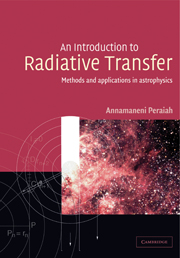Book contents
- Frontmatter
- Contents
- Preface
- Chapter 1 Definitions of fundamental quantities of the radiation field
- Chapter 2 The equation of radiative transfer
- Chapter 3 Methods of solution of the transfer equation
- Chapter 4 Two-point boundary problems
- Chapter 5 Principle of invariance
- Chapter 6 Discrete space theory
- Chapter 7 Transfer equation in moving media: the observer frame
- Chapter 8 Radiative transfer equation in the comoving frame
- Chapter 9 Escape probability methods
- Chapter 10 Operator perturbation methods
- Chapter 11 Polarization
- Chapter 12 Polarization in magnetic media
- Chapter 13 Multi-dimensional radiative transfer
- Symbol index
- Index
Chapter 13 - Multi-dimensional radiative transfer
Published online by Cambridge University Press: 05 June 2012
- Frontmatter
- Contents
- Preface
- Chapter 1 Definitions of fundamental quantities of the radiation field
- Chapter 2 The equation of radiative transfer
- Chapter 3 Methods of solution of the transfer equation
- Chapter 4 Two-point boundary problems
- Chapter 5 Principle of invariance
- Chapter 6 Discrete space theory
- Chapter 7 Transfer equation in moving media: the observer frame
- Chapter 8 Radiative transfer equation in the comoving frame
- Chapter 9 Escape probability methods
- Chapter 10 Operator perturbation methods
- Chapter 11 Polarization
- Chapter 12 Polarization in magnetic media
- Chapter 13 Multi-dimensional radiative transfer
- Symbol index
- Index
Summary
Introduction
So far we have seen the problems of radiative transfer mostly in one-dimensional plane parallel or spherically symmetric geometries in the context of astrophysical situations. The book by Sen and Wilson (1990) deals extensively with the basic techniques for solving radiative transfer problems in spherically and cylindrically symmetric media (see also Leong and Sen (1969, 1970, 1971a,b), Uesugi and Tsujita (1969), Kho and Sen (1972)). Taking into account the effects of geometrical convergence and oblique incidence arising out of the sphericity of the medium, Bellman, Kagiwada, Kalaba and Ueno (see the references given in Sen and Wilson (1990)) solved the problems of the diffuse transmission of light from a central point source through an inhomogeneous spherical shell medium. Tsujita used a corresponding method to solve transfer problems in infinite cylindrical media (see Sen and Wilson (1990)). Certain approximate techniques such as ray-by-ray methods may be useful in special circumstances, but we need to explore the solution in multi-dimensional geometries so that any I (X1, Y1, Z1; t1) can be correlated to any other I (X2, Y2, Z2; t2) exactly. This is essential especially in scattering media which generate diffuse radiation fields.
However, the developments in multi-dimensional radiative transfer are not as advanced as the one-dimensional (including curved geometries) case. The solution of multi-dimensional radiative transfer is most important and is needed in astrophysical problems. We shall sketch some of the available results in this chapter.
Information
- Type
- Chapter
- Information
- An Introduction to Radiative TransferMethods and Applications in Astrophysics, pp. 441 - 468Publisher: Cambridge University PressPrint publication year: 2001
